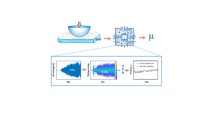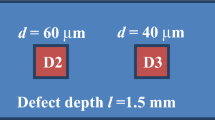Abstract
Thermosonics, also known as ultrasonic stimulated thermography, is a rapid non-destructive evaluation technique that uses an infrared camera to visualise material defects by detecting the frictional heating at crack surfaces when a part under inspection is vibrated. These vibrations are usually produced by an ultrasonic horn being pressed against the surface of the test sample, which result in uncontrolled generations of frequency components and excitation amplitude. This makes thermosonics highly non-reproducible and unreliable. This paper presents a novel thermographic method, here named as nonlinear ultrasound stimulated thermography, for the detection and imaging of real material defects such as impact damage on a complex composite stiffener panel. This technique combines nonlinear ultrasonic techniques with thermography. A nonlinear ultrasonic approach was used as signature for a reliable frequency-selective excitation of material defects, while an infrared camera was employed to reveal the damage location and severity. A nonlinear narrow sweep excitation method was employed to efficiently excite the local resonance frequencies of the damaged region in order to give rise to the highest nonlinear harmonic response in the material leading to a high heat generation at the crack surface. The experimental tests were carried out with a laser vibrometer in order to better understand the interaction of elastic waves with nonlinear scattering. An ad-hoc nonlinear thermal-structural finite element and crack model was developed to study the heat generation caused by the movement of the crack surfaces when elastic waves with a particular frequency impinges on the crack interphase with good agreement with the experimental results. The proposed new method allows to detect single and multiple barely visible impact damage in a quick, reliable and reproducible manner and overcomes the main limitations of classical thermosonics.
























Similar content being viewed by others
References
DiMambro, J., et al.: Sonic infrared (IR) imaging and fluorescent penetrant inspection probability of detection (POD) comparison. In: AIP Conference Proceedings Review of Progress in Quantitative Nondestructive Evaluation (2007)
Kang, B.B.: Excitation Method for Thermosonic Non-destructive Testing. Imperial College, London (2008)
Reifsnider, K., Henneke, E.G., Stinchcomb, W.: The Mechanics of Vibrothermography. Mechanics of Nondestructive Testing, pp. 249–276. Plenum Press, New York (1980)
Lu, J., et al.: Study of the effect of crack closure in sonic infrared imaging. Nondestruct. Test. Eval. 22(2–3), 127–135 (2007)
Homma, C., et al.: Study of the heat generation mechanism in acoustic thermography. In: AIP Conference Proceedings Quantitative Nondestructive Evaluation (2006)
Renshaw, J., et al.: The sources of heat generation in vibrothermography. NDT & E Int. 44(8), 736–739 (2011)
Favro, L., et al.: Infrared imaging of defects heated by a sonic pulse. Rev. Sci. Instrum. 71(6), 2418–2421 (2000)
Favro, L., et al.: Sonic IR imaging of cracks and delaminations. Anal. Sci. 17, s451–s453 (2002)
Favro, L., et al.: Sonic infrared imaging of fatigue cracks. Int. J. Fatigue 23, 471–476 (2001)
Solodov, I.: Local defect resonance (LDR): a route to highly efficient thermosonic and nonlinear ultrasonic NDT. In: 40th Annual Review of Progress in Quantitative Nondestructive Evaluation: Incorporating the 10th International Conference on Barkhausen Noise and Micromagnetic Testing (2014)
Solodov, I., et al.: A local defect resonance to enhance acoustic wave-defect interaction in ultrasonic nondestructive evaluation. Appl. Phys. Lett. 99(21), 211911 (2011)
Shuyu, L.: Equivalent circuits and directivity patterns of air-coupled ultrasonic transducers. J. Acoust. Soc. Am. 109(3), 949–957 (2001)
Fletcher, L.: Recent developments in contact conductance heat transfer. J. Heat Transf. 110(4b), 1059–1070 (1988)
Vick, B., Furey, M.J., Kajdas, C.: An examination of thermionic emission due to frictionally generated temperatures. Tribol. Lett. 13(2), 147–153 (2002)
Vick, B., Furey, M.J.: A basic theoretical study of the temperature rise in sliding contact with multiple contacts. Tribol. Int. 34(12), 823–829 (2001)
Vick, B., Ozisik, M.: Quasi-steady-state temperature distribution in periodically contacting finite regions. J. Heat Transf. 103(4), 739–744 (1981)
Shojaeefard, M., Goudarzi, K., Mazidi, M.S.: Inverse heat transfer problem of thermal contact conductance estimation in periodically contacting surfaces. J. Thermal Sci. 18(2), 150–159 (2009)
Ovcharenko, A., et al.: Transient thermomechanical contact of an impacting sphere on a moving flat. J. Tribol. 133(3), 031404 (2011)
Fierro, G.M., et al.: Nonlinear ultrasound modelling and validation of fatigue damage. J. Sound Vib. 343, 121–130 (2015)
Fierro, G.P.M., Meo, M.: Residual fatigue life estimation using a nonlinear ultrasound modulation method. Smart Mater. Struct. 24(2), 025040 (2015)
Boccardi, S., et al.: Nonlinear damage detection and localisation using a time domain approach. In: Structural Health Monitoring (2015)
Fierro, G.P.M., Meo, M.: Nonlinear imaging (NIM) of flaws in a complex composite stiffened panel using a constructive nonlinear array (CNA) technique. Ultrasonics 74, 30–47 (2017)
Cantrell, J.H.: Fundamentals and applications of nonlinear ultrasonic nondestructive evaluation. In: Kundu, T. (ed.) Engineering and Biological Material Characterization, Ultrasonic Nondestructive Evaluation, pp. 363–434. CRC Press, Boca Raton (2004)
Ciampa, F., et al.: Detection and modelling of nonlinear elastic response in damaged composite structures. J. Nondestruct. Eval. 33(4), 515–521 (2014)
Popov, V.L.: Rigorous treatment of contact problems—Hertzian contact. Contact Mechanics and Friction, pp. 55–70. Springer, Berlin (2010)
Basu, B., Kalin, M.: A Materials Science Perspective, Tribology of Ceramics and Composites. Frictional Heating and Contact Temperature. Wiley, Hoboken (2011)
Pickering, S., et al.: LED optical excitation for the long pulse and lock-in thermographic techniques. NDT & E Int. 58, 72–77 (2013)
Bremond, P., Potet. P.: Lock-in thermography: a tool to analyze and locate thermomechanical mechanisms in materials and structures. In: Aerospace/Defense Sensing, Simulation, and Controls. International Society for Optics and Photonics (2001)
Ibarra-Castanedo, C., et al.: Inspection of aerospace materials by pulsed thermography, lock-in thermography, and vibrothermography: a comparative study. In: Defense and Security Symposium. International Society for Optics and Photonics (2007)
Dillenz, A., et al.: Progress in phase angle thermography. Rev. Sci. Instrum. 74(1), 417–419 (2003)
Stanley, P., Chan, W.: The application of thermoelastic stress analysis techniques to composite materials. J. Strain Anal. Eng. Des. 23(3), 137–143 (1988)
Fierro, G.P.M., et al.: Nonlinear thermosonics and laser vibrometry for barely visible impact damage of a composite stiffener panel. In: SPIE Smart Structures and Materials + Nondestructive Evaluation and Health Monitoring. International Society for Optics and Photonics (2016)
Oswald-Tranta, B., Shepard, S.M.: Comparison of pulse phase and thermographic signal reconstruction processing methods. In: SPIE Defense, Security, and Sensing. International Society for Optics and Photonics (2013)
Bates, D., et al.: Rapid thermal non-destructive testing of aircraft components. Compos. Part B 31(3), 175–185 (2000)
Almond, D.P., Patel, P.: Photothermal Science and Techniques, vol. 10. Springer, Berlin (1996)
Ciampa, F., Barbieri, E., Meo, M.: Modelling of multiscale nonlinear interaction of elastic waves with three-dimensional cracks. J. Acoust. Soc. Am. 135(6), 3209–3220 (2014)
Hallquist, J.O.: LS-DYNA theory manual. Livermore Software Technology Corporation (LSTC) (2006)
LS-DYNA Keyword User’s Manual. LSTC (2014). www.lstc.com
Acknowledgements
Michele Meo would like to acknowledge the EU FP-7 “ALAMSA” project (Grant Agreement Number 314768), whilst Francesco Ciampa would acknowledge the EPSRC “NUSIT” Project (EP/N016386/1).
Author information
Authors and Affiliations
Corresponding author
Rights and permissions
About this article
Cite this article
Fierro, G.P.M., Ginzburg, D., Ciampa, F. et al. Imaging of Barely Visible Impact Damage on a Complex Composite Stiffened Panel Using a Nonlinear Ultrasound Stimulated Thermography Approach. J Nondestruct Eval 36, 69 (2017). https://doi.org/10.1007/s10921-017-0449-x
Received:
Accepted:
Published:
DOI: https://doi.org/10.1007/s10921-017-0449-x




